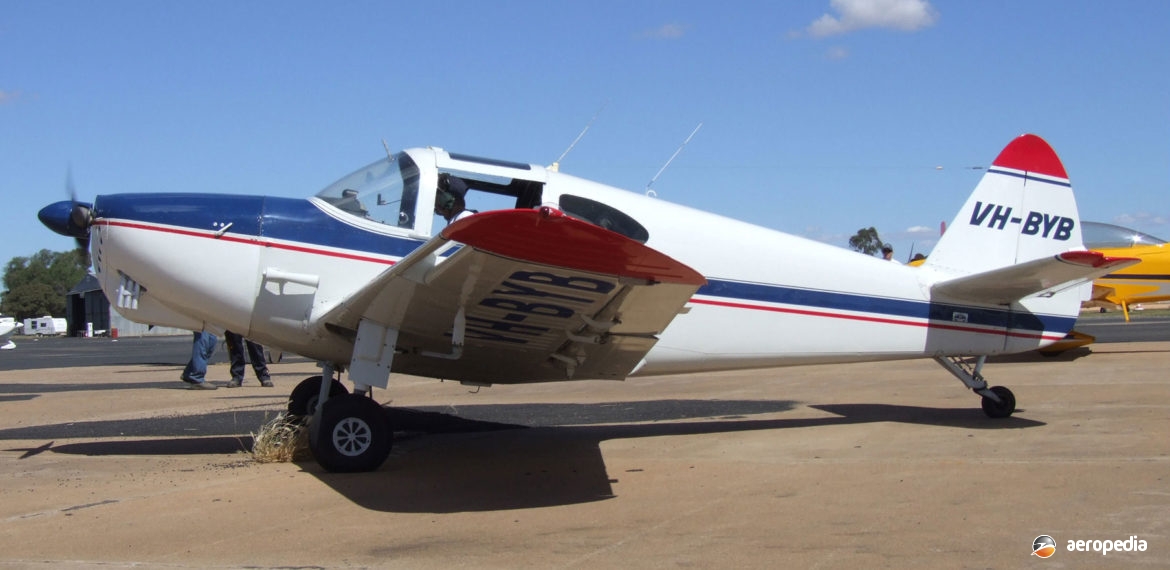Photograph:
Globe GCB-1B Swift VH-BYB (c/n 2086) at Narromine, NSW in April 2007 (David C Eyre)
Country of origin:
United States of America
Description:
Two-seat light sport cabin monoplane
Power Plant:
One 93 kw (125 hp) Continental C-125 six-cylinder horizontally-opposed air-cooled engine
Specifications:
- Wingspan: 8.96 m (29 ft 4 in)
- Length: 6.12 m (20 ft 10¾ in)
- Height: 1.8 m (6 ft 2 in)
- Wing area: 12.22 m² (131.63 sq ft)
- Max speed at sea level: 233 km/h (145 mph)
- Cruising speed at 80% power at 2,133 m (7,000 ft): 212 km/h (132 mph)
- Cruising speed at 65% power: 201 km/h (125 mph)
- Rate of climb at sea level: 305 m/min (1,000 ft/min)
- Stalling speed no flaps: 100 km/h (61 mph)
- Service ceiling: 4,328 m (14,200 ft)
- Range at 212 km/h (132 mph): 676 km (420 miles)
- Empty weight: 507 kg (1,118 lb)
- Loaded weight: 776 kg (1,710 lb)
History:
Bennett Aircraft Corporation was formed in Texas in 1940 to develop and build, using a new material known as Duraloid, a series of light aircraft. The first aircraft designed had twin engines, had eight seats, and was known as the BTC-1. Subsequently the Swift was developed, using the “Duraloid” construction in the wing and tail but having conventional steel tube framework in the fuselage. The Duraloid process was also known as Bakelite-bonded plywood structure.
In 1941 the company re-structured and its name changed to Globe Aircraft Corporation, the new “Swift” having a 48 kw (65 hp) Continental engine. This was subsequently replaced with a 60 kw (80 hp) unit, and development continued to the Model GC-1. However, World War II intervened and the design was shelved until 1946.
At the conclusion of the war further development took place, and the Model GC-1A was announced, fitted with the 63 kw (85 hp) C-85 Continental engine. In the event the manufacturer considered it a little under-powered and, after 375 examples were built, the six-cylinder C-125 engine was installed, it then becoming known as the GC-1B.
The type sold well, and the Company had a huge backlog of orders when, in 1947, it filed for bankruptcy. At this time Temco (The Texas Engineering & Manufacturing Company) was assisting in production to meet orders, and had already itself delivered 330 aircraft, all built at the former North American plant at Dallas, Texas. Temco then acquired the design rights and continued development but stopped production in 1951 due to the company’s military commitments with the Korean War.
It is not known how many Swifts were built but it has been reported some 1,239 examples were completed in 1946 alone. Many Swifts have been modified in various ways, some being fitted with a 108 kw (145 hp) Continental O-300 engine, and up to a 186 kw (250 hp) Franklin engine. One was fitted with an Allison 250 turboprop.
The fuselage framework was semi-monocoque, all-metal structure, covered with alclad sheet. The tapered cantilever wing was built up of dural metal spar beams and stamped out dural metal wing ribs, the framework being covered with sheet metal. The aircraft was stressed to +7.2G and –4.4 G.
Two examples have been imported to this region, the first a GC-1B (c/n 1293) being imported into Sydney, NSW in 1992 and becoming VH-XTG, later moving to Queensland; the second a GC-1B (c/n 2086) becoming VH-BYB in February 1993, which for a period was based on the south coast of New South Wales.
In 2010 an example was imported to Auckland, New Zealand for restoration.

